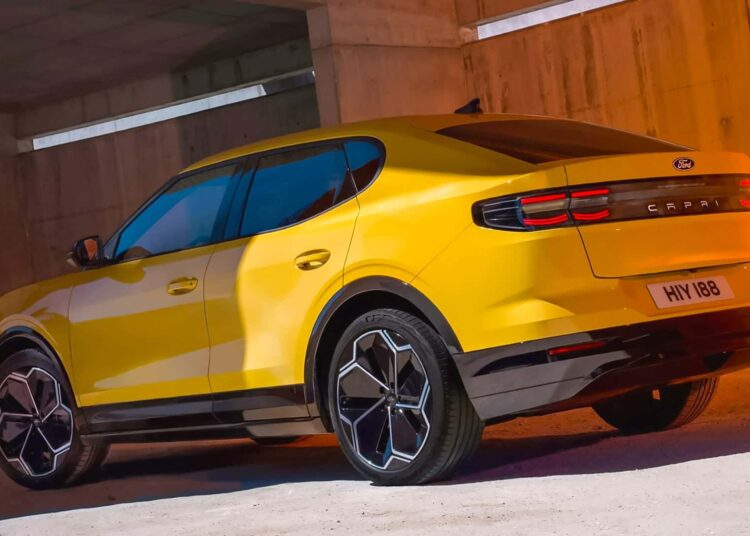After slapping the Puma badge on a crossover, Ford is doing it again with another fabled European nameplate. Say hello to the new Capri, which represents a striking change from the fastback coupe sold between the late 1960s and the mid-1980s. While the original model was marketed as the Euro Mustang, its modern-day equivalent is just another electric SUV.
Essentially, the Capri is a coupe-styled derivative of the fully electric Ford Explorer sold in Europe. Both sit on the Volkswagen Group’s MEB platform, so you can think of the Capri as Ford’s equivalent of the ID.5 while the Explorer is a reskinned ID.4. It’s a stark departure from the original Capri–a true Ford since it was mechanically related to the Cortina.
I might have exaggerated by saying it has coupe influences since the roofline is nearly flat, so much so the car looks like a jacked-up sedan when viewed from the side. It reminds me of Mercedes-Maybach’s weird SUV-sedan mashup from 2018 but better executed. While it doesn’t look half bad, its shape and styling are nowhere near as desirable as the namesake cars from yesteryear.
On to the specs, shall we? The new Capri is 182.4 inches long, 73.7 inches wide, and 64 inches tall, with a wheelbase of 109 inches. Unsurprisingly, its proportions nearly match those of the not-for-America VW ID.5. Ford intends to sell the electric SUV with standard 19-inch wheels, but larger 20- and 21-inch sets are going to be available as well.
The base version will have a rear-wheel-drive layout with a single electric motor rated at 282 horsepower and 402 pound-feet of torque. It has enough muscle for a 0 to 62 mph sprint in 6.4 seconds and an electronically governed top speed of just 119 mph. Ford sold faster Capris back in the day…
The Blue Oval installs a lithium-ion nickel-manganese-cobalt (Li-NMC) battery pack with a usable energy content of 77 kWh, good for 390 miles of range in the WLTP cycle. Once you’re out of juice, it takes about 28 minutes to “fill up” the battery from 10 to 80 percent at a DC charging station using 135 kW.

Step up to the dual-motor variant and the Capri gets a front-mounted motor. This all-wheel-drive model delivers a combined horsepower of 335 hp and 501 lb-ft, therefore matching the VW ID.5 GTX. The same goes for the single-motor Capri since it mirrors the output of the non-GTX ID.5. That’s hardly a surprise since the two cars are cut from the same cloth.
Courtesy of the additional grunt, the sprint time drops to 5.3 seconds, making it 1.1 seconds quicker than the rear-wheel-drive model. You not only get extra oomph with the dual-motor Capri but also a slightly larger battery and faster charging. The 79-kWh pack can be replenished from 10 to 80 percent in 26 minutes when using the maximum permitted charging power of 185 kW. Fully charged, it provides 368 miles of range. That’s down by 22 miles compared to the rear-wheel-drive model.
While the Capri from the old days weighed from just over 2,000 pounds to nearly 2,700 lbs depending on the generation, the electric SUV is much heavier. Mild shock, right? The base model tips the scales at around 4,625 lbs while the range-topping version with AWD weighs 4,828 lbs.

Seen here in Vivid Yellow as a nod to the Capri RS, the electric SUV has largely the same cabin as the conventionally shaped Explorer. It borrows the vertically oriented 14.6-inch touchscreen that moves up and down to reveal a “secret” storage compartment located behind.
You’re not sacrificing practicality by getting the Capri since there’s 20.1 cubic feet of storage space behind the seats. Fold them and the luggage capacity jumps to 53.3 cu ft. These numbers actually surpass those of the Explorer, which has 15.9 cu ft with the rear bench up and 49.4 cu ft after dropping the second row. The surprising difference likely stems from the fact the Capri is around 6.5 inches longer despite carrying an identical wheelbase.
Much like the Explorer, the revived Capri is going to be assembled in Cologne, Germany. Local pricing kicks off at €51,950 ($56,180) for the rear-wheel-drive model. That makes it €2,450 ($2,650) more expensive than the base Explorer.
The Puma and Capri are not the only Ford monikers of historical importance to be bitten by the SUV bug. The Mustang Mach-E also banks on the branding power of what is arguably the company’s most desirable nameplate. Of the three, only the Puma isn’t an EV. However, that’s about to change since an electric version is coming out later this year when it’ll join the gas model.
Read the full article here


























